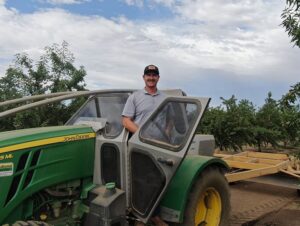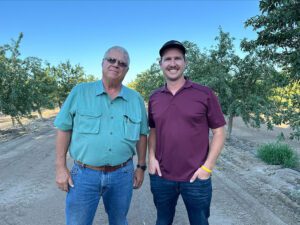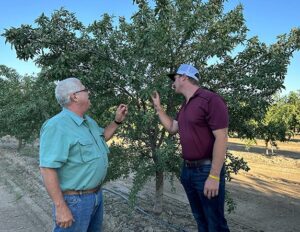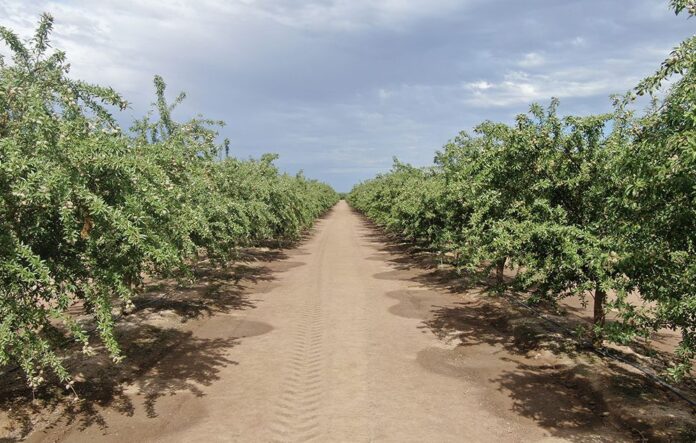Future Farmers of America (FFA) lived up to its name in helping to push Mark Cavallero, of Cavallero Farms, into almond farming. As do most farm kids, Cavallero saw working on the farm as a ‘chore.’ It wasn’t until his FFA advisor suggested he compete for the FFA’s Proficiency Award that he found his true love for growing almonds.
“The impact and the ripple effect of the FFA program definitely shaped me into the person I am today,” Cavallero said.
Today, Cavallero and his dad continue to farm the family’s land in Madera, Calif, making Cavallero Farms a fourth-generation operation. Both he and his dad, Jim Cavallero, carry full-time jobs outside of the farm. After the outside jobs are done, farming of the 40 acres of Independence almonds begins.

Q. What’s the history of farming for you or your family?
The Cavallero operation began in 1912, established by my great grandfather Giuseppe Cavallero. Giuseppe Cavallero purchased 450 acres of land and began to farm grapes and cotton. Our family maintains ownership over parts of the original farm, but slowly, faced with the unique difficulties of farming in California, acres were sold. The operation is now based on what we call, “The Home 60.” My Dad made the decision to plant almonds in 1996, coincidentally the year I was born. I like to think I was literally born into the modern Cavallero Farming operation. Our almond operation and I have literally grown up together.
The transition to 100% almonds did not happen immediately. We maintained acreage of grape production for several years, but the market conditions for that crop ultimately led us to 100% almond production. In 2015, we removed most of the original trees and redeveloped with a block of Independence variety. The new variety did great, leading us to the decision to remove a small section of Butte/Padre and replant with Independence. Shortly after, we removed our last 10 acres of Thompson Seedless grapes, and with total consistency, completed our farm with 100% Independence plantings.
Q. What’s your story of how you ended up in the industry?
Being born, raised and educated in Madera Calif., I eventually landed in the Madera FFA Chapter once enrolled in high school. I was very active within the FFA program for four years and was also awarded the prestigious American FFA Degree. I enjoyed my time within the FFA program, but I was still missing the passion that I have today.
As I moved through the stages of FFA, I was exposed to many different activities and competitions, some of which included showing market animals and farm and ranch production competitions against other FFA members and their respective farms. My farm project took me all the way to the National FFA competition. At that point, I realized, “Oh, well, this is actually pretty fun, and I kind of enjoy the farming aspect now.”
After high school, I attended Reedley College with a focus on plant science. My initial plan was to be a PCA. Then COVID-19 happened, and I’m not great at learning from a computer. I was presented with an opportunity to work as a Grower Representative for Sierra Valley Almonds. I applied, interviewed, and I’ve been here since September 2020.
Q. Talk a little bit about what it’s like to be a smaller farm in the industry.
It’s tough in a way, and it’s rewarding in others. At the end of the day, we don’t do anything different than a large-scale operation. We spray, we mow, we irrigate, we fertilize, we do everything that a large-scale operation does. The only difference, and it’s kind of the nice part, is it’s just me and my dad. We have no employees. It’s just the two of us, running the day-to-day, week-to-week processes.
On certain jobs, we’ll bring in pruning crews. We have one guy that helps us with irrigation occasionally because my dad and I both work full-time jobs. With some of the time-sensitive jobs, we will bring in some outside help, the same as a larger-scale operation will do.
I would say that one unique struggle as a small operation is that some companies might scoff off a smaller business because the payoff will be less. A large operation is going to hire a larger scale of service, which leads to a higher amount due for the service. We’ve built very good relationships with outside companies, but in the beginning, it was tough finding those companies that were willing to provide the smaller-scale services we needed.
Q. How does your passion for farming blend with your day job?
A lot of growers don’t know exactly what processors do. Farmers are experts at farming. There can be a lack of connection and understanding between the field production and processors. With my employment at [Sierra Valley Almonds], I have learned there are multiple steps in the processing of almonds. The supply chain from field to consumer is built on the backs of very important companies and people, everyone working together to get our product to market. It has been a very enlightening few years. With my current job as a grower representative, I have hands-on involvement from start to finish.
I am fortunate to have the ability to grow my almonds, nurture them to production, harvest them and transport them to the huller/sheller, which is the first step… to prepare them for either kernel or in-shell processing. From there, the kernels are shipped to the processing facility where they are USDA graded. At this point, my incoming grower analysis determines the quality of my almonds. This is where I finally see the results of my crop. Then the kernels are sized and graded and ultimately sold to buyers who prefer the Independence variety. The Middle East has become a fantastic market for this young variety, and the industry has done a great job marketing them as a nice-looking alternative to the Nonpareils.
Having the lifelong experiences of farming and developing my knowledge by working for a processor, I am able to bring a unique perspective to other growers who contract with Sierra Valley. I understand their concerns, the big financial investments that go into maintaining a permanent crop like almonds, but I am also able to communicate the unique characteristics of the global almond market to our growers. Farmers are experts at producing great crops, and I am proud to be a conduit of information between the daily market conditions and the marketing plans of our growers.
I can genuinely relate to my growers. I know exactly what it’s like from start to finish. I know exactly when they’re spraying, and I know what they’re spraying because I’m doing the exact same thing. I know when the weather is affecting their crops because it’s also affecting mine.
My dual involvement bridges that gap from processor to grower. I am that middle lightning rod that connects everyone together.
Q. Talk a little bit about how you juggle farming and working a full-time job.
It’s definitely a lot of communication between my dad and I. For example, this afternoon we’re going to hook up a disc for some planned orchard management. The longer days make it nice. I get off work around 4 p.m. or 5 p.m. Monday through Friday. It’s all about communication for both of us, planning what we’re going to do and executing it, the same as any farming operation.
On weekends, we work as much as we can. It can be tiring at times, but it’s just something we know we have to get done, and it keeps us going. I know it keeps him young. He says the day he stops farming is the day he dies. So, we just do it, and overall, we make it work. We do the best we can.
Q. Going back to the farming side of things, how would you say farming practices have evolved over the time that you’ve been farming?
Technology is a big one, and my dad and I still butt heads about that. He’s still on the old-school side, and at the end of the day, it is his ranch. I help when I can, and I do a lot. We have a great relationship, and we share ideas, but it’s his ranch, and he’s the one writing the checks. I don’t always get the final say, but we’ve made a lot of advancements in how we farm.
Unfortunately, we are a little bit smaller, so making things fully autonomous is quite expensive for us and not always a viable option. Our most recent upgrade was installing solar energy to our farm. Our entire ranch is on solar, which is nice. The up-front cost is big, but over time, it will lower our cost of production.
Another improvement made this past year, it’s really simple, and every farmer appreciates this: We finally got a nice, new tractor. We’ve been using older equipment for a long time, and having that efficiency, having a nice cab, being able to go out essentially whenever you need to, and you’re not battling the elements, it’s been a really nice upgrade for us. It’s something as small as a new tractor that changes what we can and can’t do.
Q. What are the three things that keep you up at night related to almonds?
The three things right now that keep us up at night are 100% almond prices. Obviously, we wish prices were higher. Current pricing is simply the result of global shipments versus a very robust total supply. We have a lot of almonds and a lot of acres still that are being planted. So those definitely keep me up at night.
The other one is water. Water is a big, big issue. SGMA, which is the Sustainable Groundwater Management Act, is coming in here in 2025. Overall, we’re pretty fortunate to be in the Madera irrigation district as of right now. We should be fine, but it’s definitely something to be thinking about coming here in the near future.
The future of farming is the third concern. I don’t know exactly where California farming is going, and it really seems like people don’t want us to farm here in California. California is a unique state with excellent agriculture production, and it often feels like the masses want ag out of California.
Q. What do you think needs to be done to bring almond prices up?
Right now, the biggest target is consumption. The global market is in a weird place. Shipment numbers have been good this season, and the crop was smaller than the previous year. But prices are still flirting with a breakeven/profitable return to growers. The Almond Board of California (ABC) is doing great things to get almonds into the hands of consumers in other ways in addition to snacking in the established markets.
ABC is talking about almonds in beauty, health and fitness. There are so many other things, and almonds are beneficial for more than just a handful a day. Almonds are an excellent protein for those who prefer a plant-based diet. They’re trying to promote it in other countries as well, definitely pushing it outside the States.
Unfortunately, almonds are a luxury, not a necessity as far as a staple. We export quite a bit of almonds, close to 80% of all California almonds go all over the world. But they are a luxury, not a necessity. People need wheat, rice, grains and cheaper staples to eat.
Another factor is Australia. It’s the second-largest producer of almonds. They’re on the other side of the hemisphere, so they’re harvesting now while we just finished bloom. During the California bloom time, the Australian almonds are perceived as a fresher alternative to California. Buyers will want the freshest almonds they can get, so while the Australian almonds are being marketed, it can cause a slight drag to California almond prices.
Right now, our supply is high, and our demand is flat. I don’t know what we can really do to get almonds back up to what I think would be a fair price. You can ask a thousand growers, and they’ll all have a different number in their head of what a fair price is, ranging from $4 a pound to $2 a pound. Eventually, something has to give.
I think overall acres will start going down. They already did in this past acreage report that we got. It’s just a waiting game, and we’ll see who is around to benefit from it if that ever happens.

Q. You talked a little bit about the future and not knowing exactly where California farming is going, but what are you hopeful for about the future?
We do it because we love it. But we are farmers, so we’re going to sit there and complain, argue and bicker (all with love, obviously), and we have every bad word to say under the sun about it. But it’s just who we are. It’s something I don’t think I can live without.
Eventually, when I do get married and have kids, that’s something I’d like to teach my kids. Farming taught me how to work, to be outside, and it shaped me into the man I am today. I would love to give that to the next generation, I’d love to have a fifth-generation farmer out there farming the same ground that my great-grandfather farmed over 100 years ago. We do it for them. We do it because we love it, even if it doesn’t pan out 100% of the time.
Q. The water situation in California is on everybody’s mind. What have you changed or done for your operation when it comes to water?
Well, the biggest thing is we try not to pump from our groundwater well, and instead we try to rely on our ditch water, which comes from the snow melt. It’s what fills the canals every year. This year, we were fortunate to get water at the beginning of April. You buy it at a per-acre-foot rate, and it’s $110 an acre this year here in Madera, which really isn’t that bad. It’s one of the earliest years we’ve had water aside from last year in a while.
We try to use that water at that time, and now we’re recharging our aquifer instead of pulling out from it. We’ve talked about it, and we have 15 acres of fallow ground at my ranch. We’ve considered building retention ponds instead of planting almonds to help recharge in that way. I think that would be most beneficial.
We’re definitely water-conscious. We’re trying to do everything we can, and it’s not just us. It’s growers all over the state, and it’s tough for sure, but all of us want to do it. I feel like farmers are the biggest stewards of the land. We know the land, we know what it wants and needs, and we’re willing to help in any way we can.
Q. What would you say are the biggest assets of the almond industry in California?
The biggest assets are the growers. Without farmers, there are no almonds. Every single grower that farms almonds is equally important.
I believe that Western Ag Processors Association (WAPA), The Almond Alliance and the Almond Board of California are solid assets. The Almond Alliance helps us lobby and get things done in D.C. They’re knocking down doors and doing what small growers can’t do. The Western Agricultural Processors Association is an organization committed to representing the tree nut industry on critical issues such as food safety, air quality, pesticides, worker safety, labor, transportation, water and water quality. WAPA is focused on regulatory and legislative issues. Neither WAPA nor the Almond Alliance market or promote.
The Almond Board of California promotes and campaigns for increased almond consumption. ABC does not lobby due to their government involvement. They’re using the annual assessment dollars for nutritional research, communication and outreach to new and emerging markets to ensure everyone knows the benefits of almonds. The amount of work they do behind the scenes is incredible.
Q. What is your proudest or biggest achievement when it comes to your professional development or your farm?
I have a couple. In 2021, we planted 25 acres of Independence almonds. My dad let me take the reins on that, and I was able to develop it from start to finish. Seeing the fruits of my labor literally grow, we shook and processed last year for the first time, producing what I thought was an amazing first crop.
Seeing how the trees are now, how uniform they are, and the neat irrigation system, it’s nice because I can say, “Hey, I did that.” It was a joint effort, but I was allowed to manage and make decisions on that new planting, and it was fun. It was definitely tough and a challenge doing it at 23 and not knowing exactly what to do. Even though I’ve been doing it for so long, knowing it deep down is different from actually doing it.
As far as my career as a grower rep, back in December, I got accepted into the Almond Leadership Program through the Almond Board of California. It started in January, and it’s been an amazing program. I’m very fortunate to be a part of it. I’ve met a lot of people and learned so much about the ins and outs of the industry that many people don’t know. I’m happy I can bridge that gap now between my growers and the Almond Board of California.

Q. Making an impact on the community around you is important for a lot of growers. In what ways do you do that?
I was really big into FFA here in Madera. If it wasn’t for FFA, I probably wouldn’t be sitting here talking to you. I still give back to them constantly. The company I work for sponsors a lot of events with them, like dinners, fundraisers and helping with the local county fair.
Personally, I help in any way I can with the young kids. They were at my ranch about a month ago for a farm tour, and I gave them a rundown of what a grower representative does. I explained how almonds start, how they’re processed, how they’re harvested and everything in between. I’ll continue to do that.
I definitely want to do more. Finding the time is a little tough, but I always try to when I can. So, I definitely give back, especially to FFA.
Q. You’re pretty young yourself, but if someone, one of your friends, or a high schooler came to you and said, “I want to get into farming,” what advice would you give?
That’s a hard one. Land is very, very expensive. I mean, I feel like you can if you want to but just going out and buying land is not something that an 18-year-old kid out of high school is going to do.
If I had to give any advice, I would say go find growers. They’re always looking for help. Go run a tractor for someone, go ask for a job, do it that way, be behind the scenes on that front, and just work and see if it’s something that you want to do. Eventually, if it’s something that you want to do, go lease some land to start, and hopefully, one day you can buy it.
Q. Who was the biggest influence or mentor to you?
I have a couple. Obviously, my dad and my mom have both been super supportive and helped me out in everything I’ve done. My dad has been my main mentor in everything farming-related.
We do everything together. We still butt heads, but I know if I have any questions about anything, he’s there. And usually, as much as I hate to admit it, he has the right answer. It’s always a pretty simple one, too. It’s nice, too, because the older I get, the more technology-driven I am. We both learn a lot of things from each other, which has been nice.
As far as an overall mentor, FFA’s Julie Luxon. She was my FFA advisor my senior year. Unfortunately, she wasn’t one of my teachers (I wish she was), but she was the one that got me into all my proficiency stuff about the ranch.
She said, “You know, you work on your ranch, you should compete with others across the state.” If it wasn’t for her, I feel like I wouldn’t be where I am. I still talk to her quite a bit, and she’s the one that gets me to help the kids again. She always asks, and I owe her so much I can’t say no.
As far as work and my career, my co-worker and manager, Jim Sitton, has been a huge mentor. We both got hired about the same time. He’s been in the ag industry for over 30 years in various ag-related fields. It’s been great learning from him. The knowledge and experience he has is diverse and always ties back to supporting our growers.
Q. What would you say has been the biggest advancement in farming in your time?
I think the biggest advancement is autonomy, whether it’s an autonomous sprayer, an autonomous tractor or autonomous irrigation. With labor costs rising in California to an exponential rate, everyone’s finding a way to cut costs, it’s imperative. Simple and sweet. I think autonomy is the largest advancement we’ve seen, especially in the past 10 years alone.
Q. Do you use any regenerative farming techniques on your farm?
That’s my goal this year, to plant cover crops, especially to help with the bees and with drainage, to be regenerative overall. It’s something we’ve talked about a lot, and I’d like to try to get it into practice, whether I do it this year or going forward in 2025. But it’s something I definitely want to try.
Q. Grab your crystal ball and tell us what advancements you think are coming in the future.
I don’t know if I can see that far into the future. To go back to what I said earlier, I think autonomy is just going to get bigger and bigger, and we’re going to see it a lot more. I feel like regenerative farming as well will be larger. I don’t really know what else will have a big impact. Maybe it’s a good thing that we don’t know, and we have to wait and see what is to come because everything is constantly changing.
















